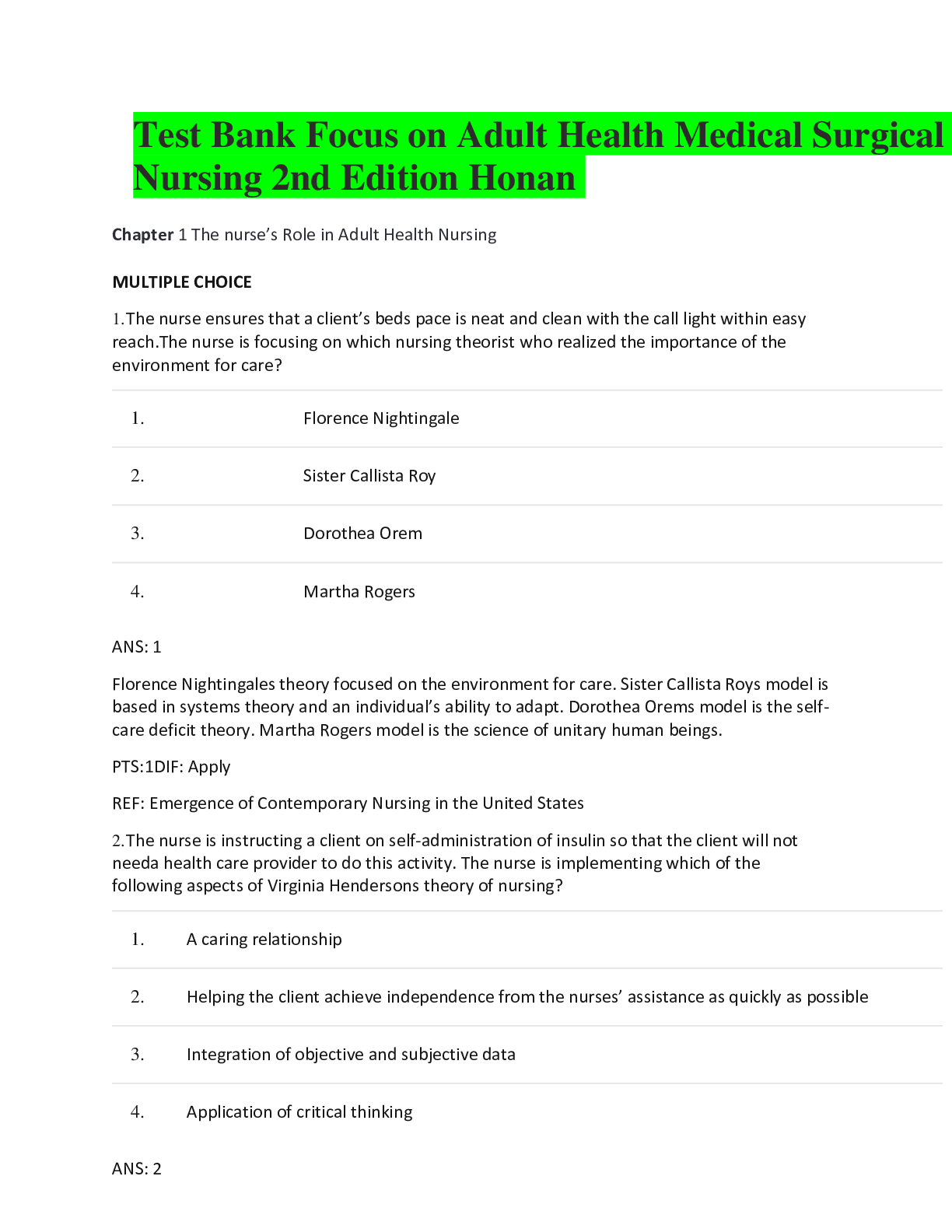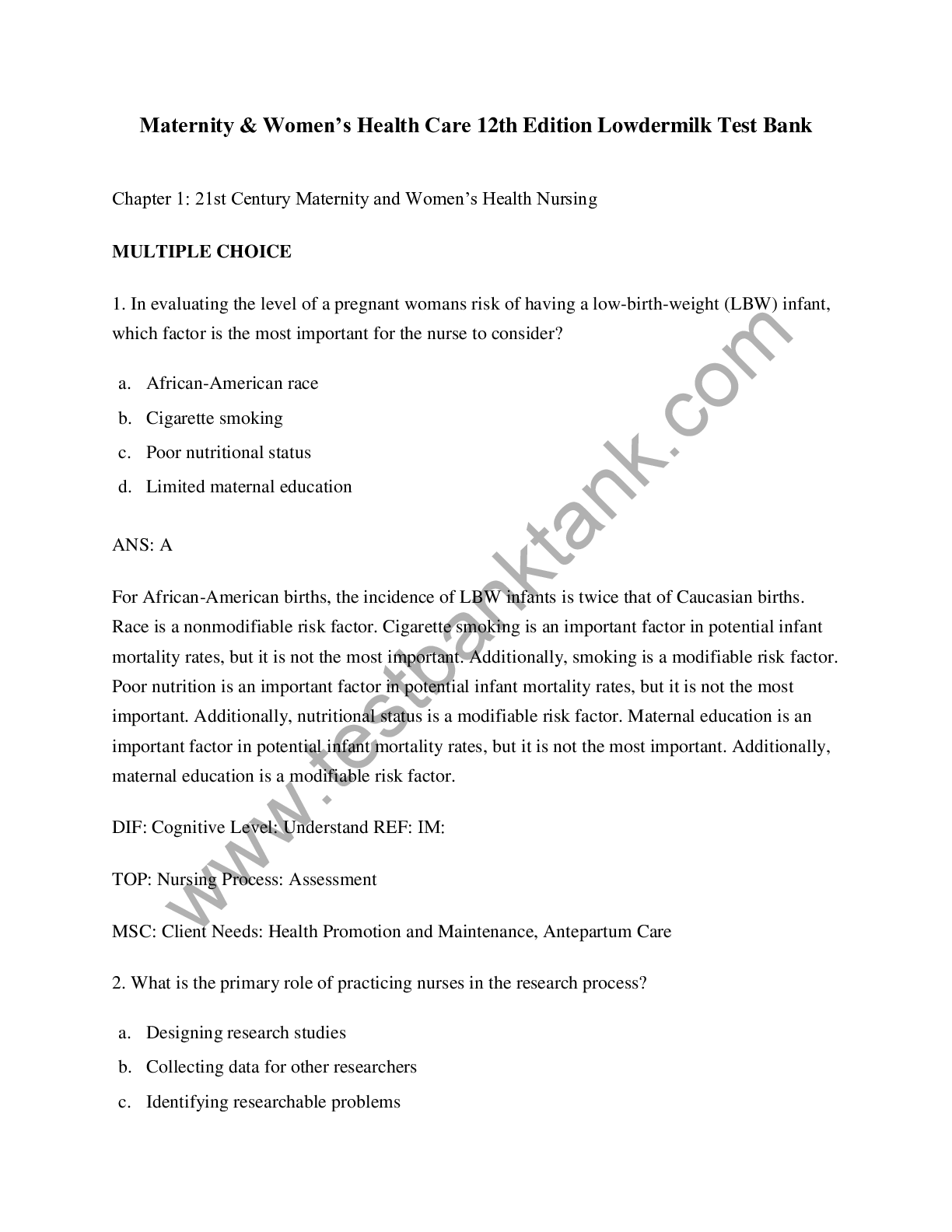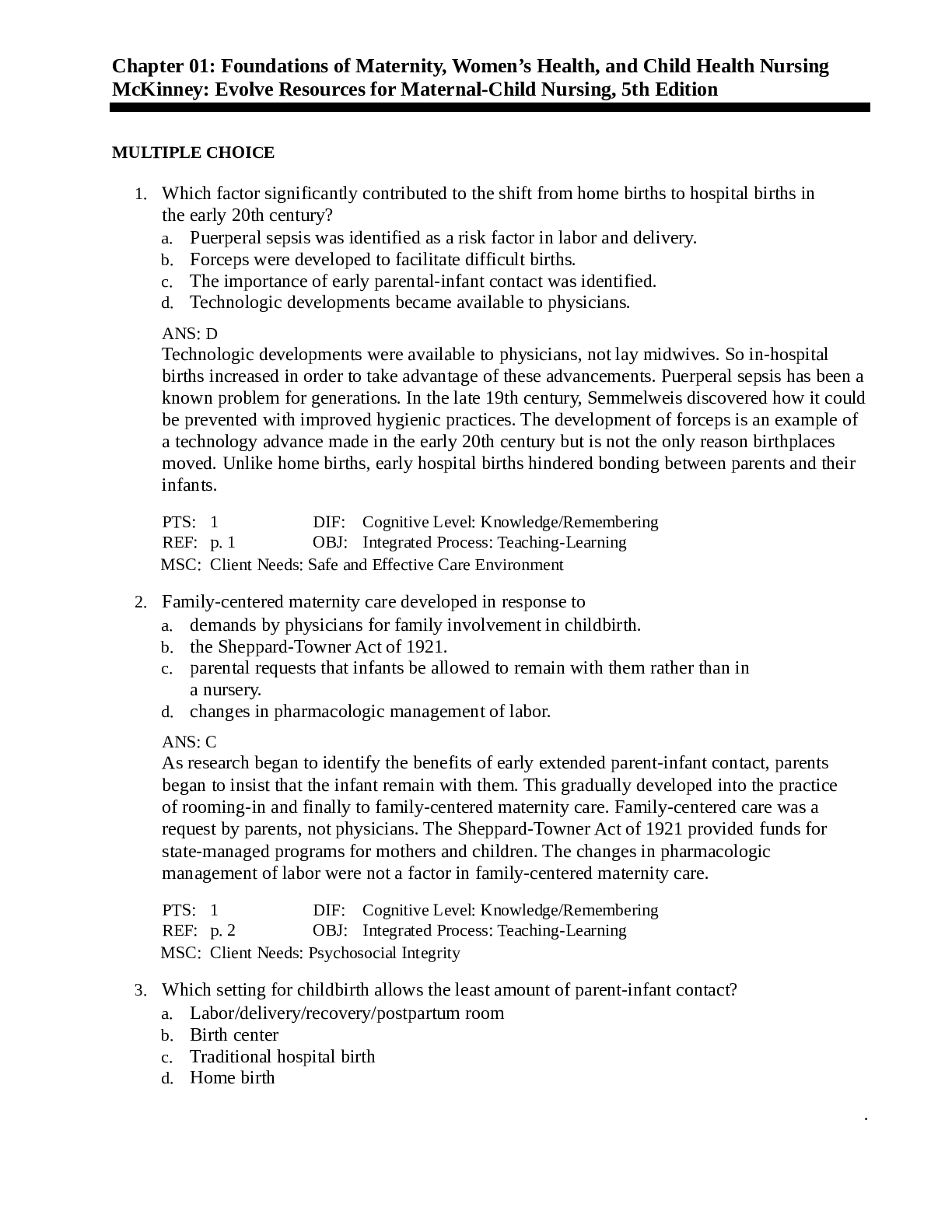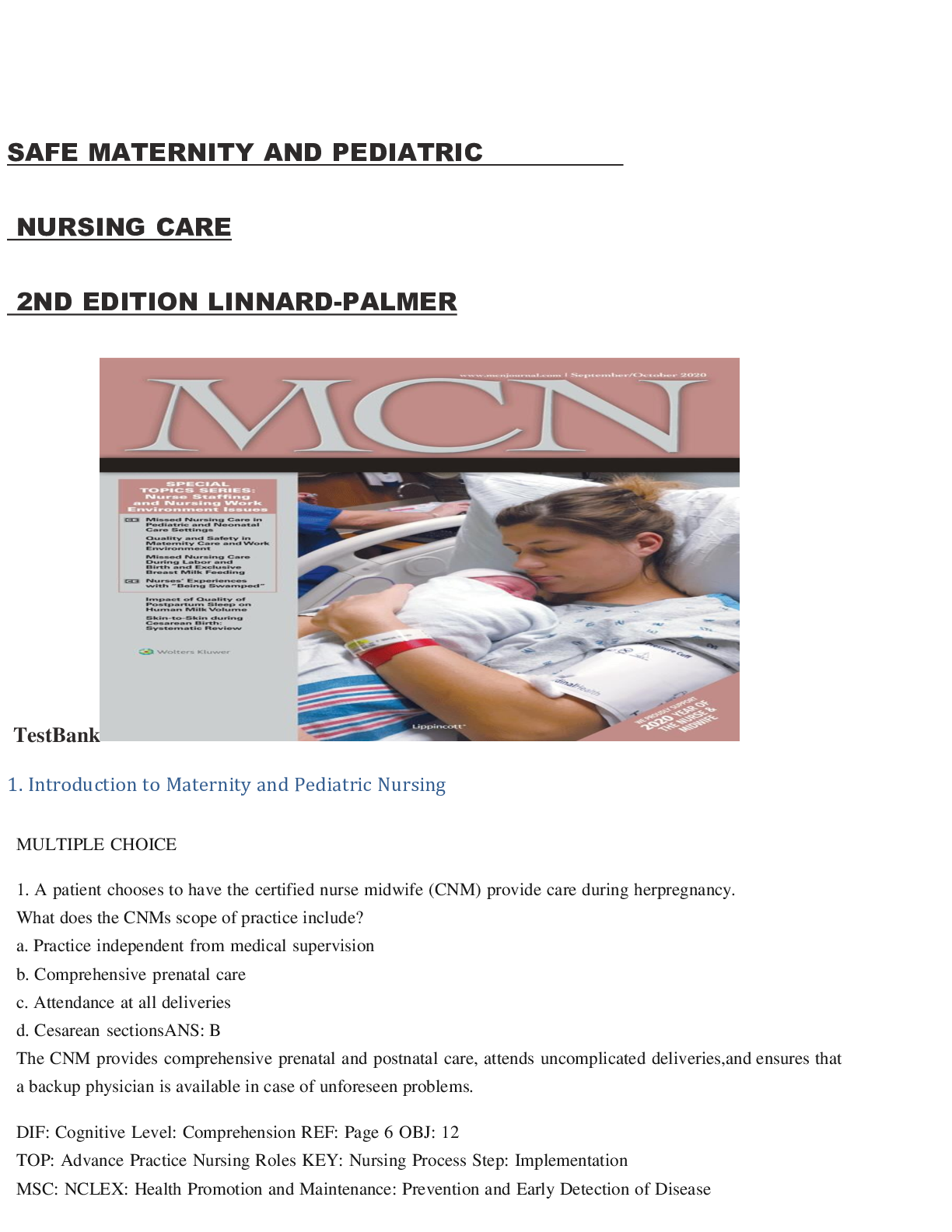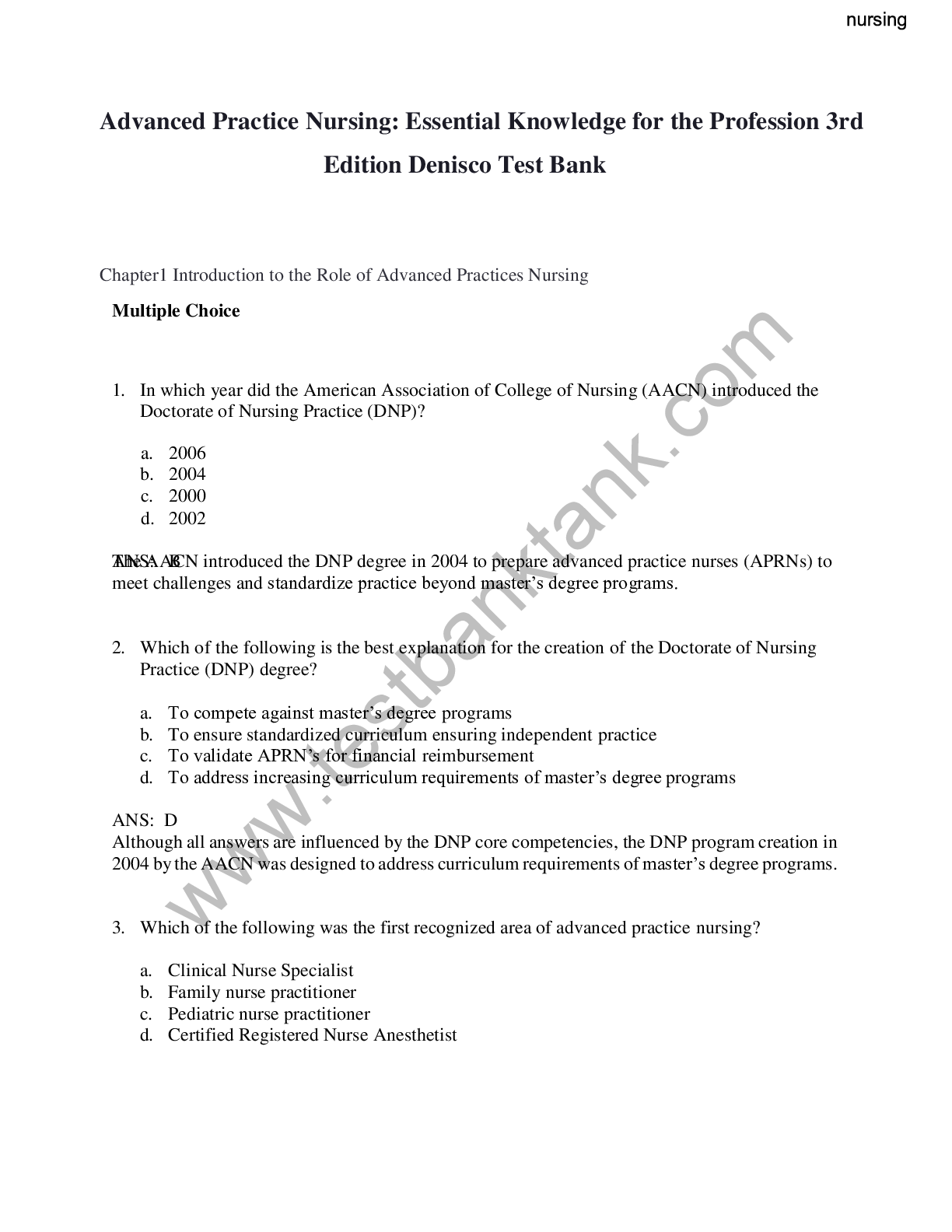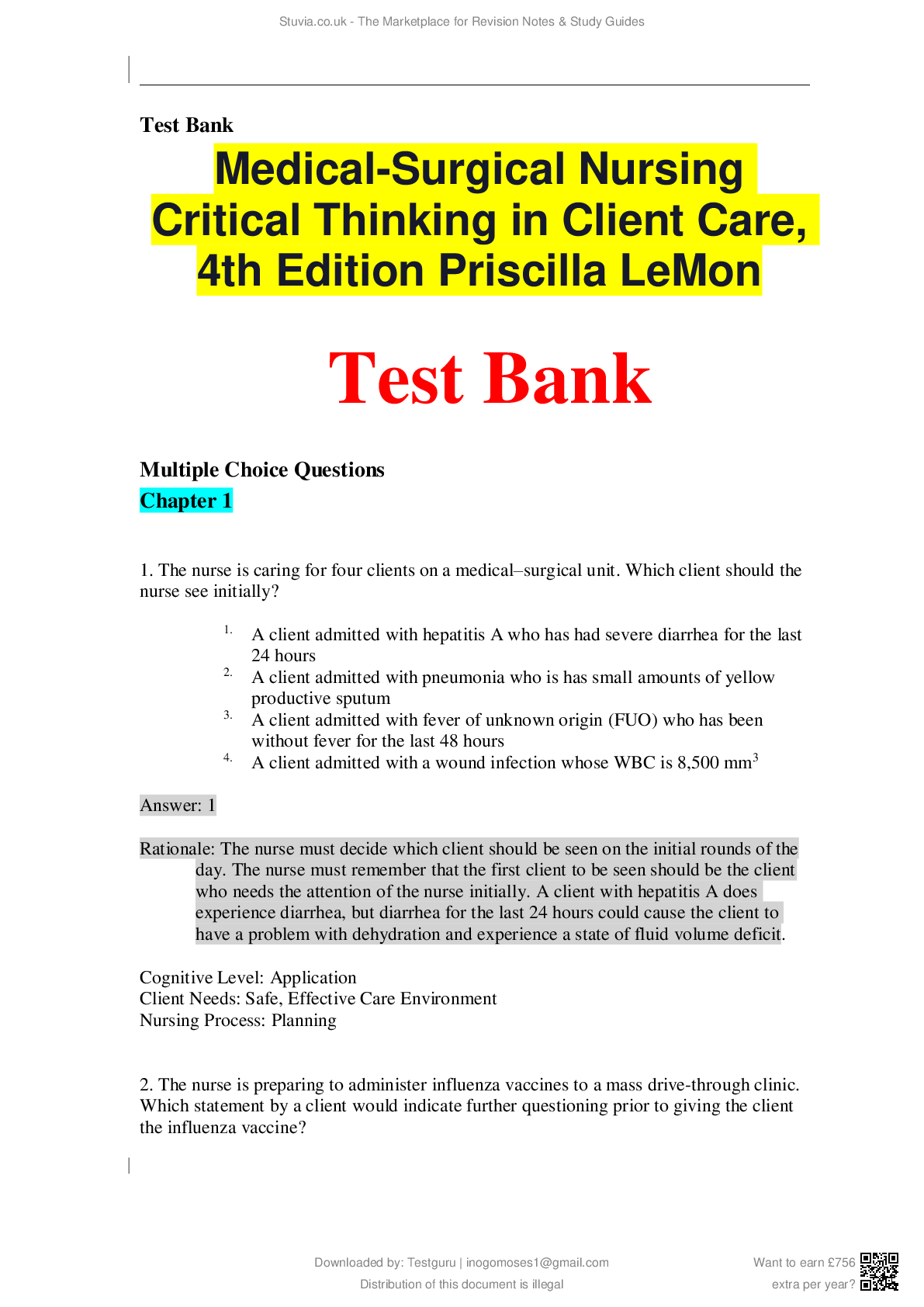*NURSING > TEST BANKS > NSG6001 test bank (All)
NSG6001 test bank
Document Content and Description Below
MULTIPLE CHOICE 1. Which of the following is a primary prevention measure for a 76-year-old man newly diagnosed with a testosterone deficiency? A. Calcium supplementation B. Testicular self-exami... nation C. Bone density test D. Digital rectal examination ANS: A PTS: 1 2. Which of the following is an example of secondary prevention in a 50-year-old woman? A. Yearly mammogram B. Low animal-fat diet C. Use of seat belt D. Daily application of sunscreen ANS: A PTS: 1 3. Which of the following is an example of tertiary prevention in a patient with chronic renal failure? A. Fluid restriction B. Hemodialysis 4 days a week C. High-protein diet D. Maintenance of blood pressure at 120/80 ANS: B PTS: 1 4. Immunizations are an example of which type of prevention? A. Primary B. Secondary C. Tertiary D. Quaternary ANS: A PTS: 1 5. The nurse is speaking to a patient regarding endemic diseases. Which of these choices describes an endemic statistic? A. The typical incidence of influenza in a country B. The surprise outbreak of malaria in new regions C. Higher levels of Ebola in a country when compared to the previous year D. Abnormal outbreak of measles in pockets of a country ANS: A PTS: 1 6. The nurse is reviewing old and current trends in disease history. Which of these would be considered an example of a sporadic outbreak? A. The number of people diagnosed with rabies virus in 2017 B. The number of people diagnosed with chlamydia in Texas over a 1-month period C. The number influenza cases diagnosed from 1918 to 1919 D. The number of common cold cases diagnosed in Washington between October 2016 and March 2017 ANS: A PTS: 1 7. Which accurately defines incidence rate? A. The number of old cases of a disease at a point in time B. The number of cases of a disease at a point in time divided by the percentage of the population at a point in time C. The number of total cases of a disease total diagnosed at a point in time D. The number of new cases of a disease diagnosed at a point in time ANS: D PTS: 1 8. What describes a pandemic? A. An event more than epidemic magnitude affecting a single community or country over a long period of time B. An event of epidemic magnitude affecting a single community or country in a short period of time C. An event of epidemic magnitude affecting multiple communities and countries in a short period of time D. An event less than epidemic magnitude affecting multiple communities and countries over a long period of time ANS: C PTS: 1 9. Which test of health literacy can be completed quickly and provide results comparable to more time-consuming tests? A. Test of Functional Health Literacy in Adults (TOFHLA) B. Patient Health Questionnaire (PHQ-9) C. Rapid Estimate of Adult Literacy in Medicine-Short Form (REALM-SF) D. Newest Vital Sign (NVS) ANS: D PTS: 1 10. The nurse is working with a 65-year-old patient who was recently diagnosed with hypertension. The patient is concerned about their optimal health with their new diagnosis. Which nursing action is necessary for health promotion with the patient? A. Discussing appropriate stress management techniques B. Sharing with the patient how to increase sodium consumption C. Discussing with the patient exercises that increase heart rate D. Emphasizing the importance of avoiding flu vaccinations ANS: A PTS: 1 Chapter 5. Evidence-Based Care MULTIPLE CHOICE 1. What is the goal of nursing research? A. Make decisions regarding nursing education based on published literature B. Determine topics that could develop nursing knowledge C. Gather information from published literature to make decisions about application to clinical practice D. Conduct studies to develop a body of nursing knowledge ANS: D PTS: 1 2. Which is the most important question to ask in evidence-based practice? A. What findings constitute evidence? B. How will the findings be used? C. Is this a randomized controlled trial? D. What theory is being utilized? ANS: B PTS: 1 3. Nursing research should be utilized by: A. Nurses at the bedside B. Advanced practice nurses C. Nurse researchers D. Nurses at all levels of practice ANS: D PTS: 1 4. A clinical guideline may be found useful if the guideline was: A. Published 2 years ago B. Created using one group C. Authored by a relatively unknown source D. Funded by an anonymous source ANS: A PTS: 1 5. Practice guidelines are designed to: A. Be inflexible B. Be utilized in every circumstance C. Provide a reference point for decision making D. Be created by a professional organization to guide the practice of a profession ANS: C PTS: 1 6. Which of the following is an example of determining whether a crucial element of a guideline is applicable to your patients? A. There are no intended specific patients in the guideline. B. You are a primary-care provider and the guidelines were written for primary-care providers. C. Your patients have a much lower prevalence of a condition than the patients in the guideline. D. You are a pediatric oncologist and the guidelines were written for geriatric specialists. ANS: B PTS: 1 7. Which of the following would be considered the research design for Level I evidence? A. Single, well-designed, randomized clinical trial B. Systematic review of randomized clinical trial studies C. Well-designed controlled trials without randomization D. Systematic reviews of descriptive or qualitative studies ANS: B PTS: 1 8. Which of the following would be considered the research design for Level II evidence? A. Single descriptive or qualitative study B. Well-designed case control or cohort studies C. Single, well-designed, randomized clinical trial D. Systematic review of randomized clinical trial studies ANS: C PTS: 1 9. Which of the following would be considered the research design for Level III evidence? A. Well-designed controlled trials without randomization B. Systematic reviews of descriptive or qualitative studies C. Systematic review of randomized clinical trial studies D. Opinion of authorities and expert committees ANS: A PTS: 1 10. Which of the following would be considered the research design for Level IV evidence? A. Single descriptive or qualitative study B. Opinion of authorities and expert committees C. Systematic review of randomized clinical trial studies D. Well-designed controlled trials without randomization ANS: D PTS: 1 11. Which of the following would be considered the research design for Level V evidence? A. Systematic review of randomized clinical trial studies B. Well-designed controlled trials without randomization C. Systematic reviews of descriptive or qualitative studies D. Single descriptive or qualitative study ANS: C PTS: 1 12. Which of the following would be considered the research design for Level VI evidence? A. Systematic reviews of descriptive o .............................................................................CONTINUED [Show More]
Last updated: 2 years ago
Preview 1 out of 157 pages

Buy this document to get the full access instantly
Instant Download Access after purchase
Buy NowInstant download
We Accept:

Reviews( 0 )
$15.50
Can't find what you want? Try our AI powered Search
Document information
Connected school, study & course
About the document
Uploaded On
Oct 17, 2021
Number of pages
157
Written in
Additional information
This document has been written for:
Uploaded
Oct 17, 2021
Downloads
0
Views
52

